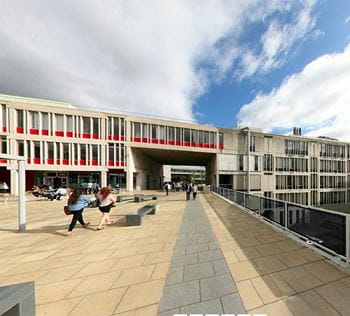MSc 5G and Emerging Communication Systems

Overview
5G and emerging communications systems will be the future of a modern life. 5G is the latest mobile technology that the UK's leading network operators are rolling out across the country, which can connect almost everything in the world with much higher speeds and capacity.
Starting from the concept of a signal, on this course you cover the fundamentals of how signals are acquired, processed, and transmitted over a wide range of media — electronic, optical, and radio. You learn how these principles are put into practice and improve your software development skills through lectures, exercises, and assignments.
Building on this, we explore a number of state-of-the-art topics in detail, including:
- modern digital transmission systems
- wireless communication systems
- computer security and cryptography
- complex electronic circuits
- networked systems
Our School of Computer Science and Electronic Engineering is a community of scholars leading the way in technological research and development. Today's telecommunications engineers are creative people who are focused and committed, yet restless and experimental. We are home to many of the world's top engineers, and our work is driven by creativity and imagination as well as technical excellence.
This course is available on a full-time and part-time basis.
Professional accreditation
Accredited by the Institution of Engineering and Technology (IET) on behalf of the Engineering Council as meeting the requirements for Further Learning for registration as a Chartered Engineer. Candidates must hold a CEng accredited BEng/BSc (Hons) undergraduate first degree to comply with full CEng registration requirements.
- Acquire robust software development skills through a number of learning methods.
- Through laboratory work, explore the fundamentals of signals – electronic, optical and radio.
- We are ranked 6th in the UK for research power in computer science (Times Higher Education research power measure, Research Excellence Framework 2021).
Our expert staff
We have been one of the leading electronics departments in the country throughout our history, and in recent years, our prolific research staff have contributed to some major breakthroughs.
We invented the world's first telephone-based system for deaf people to communicate with each other in 1981, with cameras and display devices that were able to work within the limited telephone bandwidth. Our academics have also invented a streamlined protocol system for worldwide high speed optical communications.
Our Communications and Networks (COMNET) research group specialises in 5G/6G and next generation wireless communication systems. COMNET has a long history of collaborating with other research institutions and industries including almost all the Tier-1 operators in Europe such as British Telecom (BT) and major telecom vendors such as Ericsson. Impactful patents and proposals to standardisation bodies have been generated out of these collaborations.
Specialist facilities
We are one of the largest and best resourced computer science and electronic engineering schools in the UK. Our work is supported by extensive networked computer facilities and software aids, together with a wide range of test and instrumentation equipment.
- We have six laboratories that are exclusively for computer science and electronic engineering students. Three are open 24/7, and you have free access to the labs except when there is a scheduled practical class in progress.
- All computers run either Windows 10 or are dual boot with Linux.
- Software includes Java, Prolog, C++, Perl, Mysql, MATLAB, DB2, Microsoft Office, Visual Studio, and Project.
- Students have access to CAD tools and simulators for chip design (Xilinx) and computer networks (OPNET).
- We also have specialist facilities for research into areas including non-invasive brain-computer interfaces, intelligent environments, robotics, optoelectronics, video, RF and MW, printed circuit milling, and semiconductors.
Our Communications and Networks (COMNET) research group also encompasses associated research laboratories to support the design and development of 5G networks and modern communication systems.
Your future
Our graduates work in major telecommunications companies around the world. Over 25 years we have educated over a thousand communications specialists.
Our recent graduates have progressed to a variety of careers, including senior positions in industry and academia. Some of the companies and organisations where our former graduates are now employed include:
- Elitecore Technologies Ltd
- Juniper Networks
- Cisco Systems
- Incendio Technologies
We also work with the university's Employability and Careers Centre to help you find out about further work experience, internships, placements, and voluntary opportunities.
We also offer a range of postgraduate research degrees (such as a PhD) in areas of computer science and electronic engineering, and computational finance.
"Studying at a top university in the UK for computer science will allow me to work with and learn from prominent lecturers in the field of 5G and communication systems. The opportunity to be considered for a Chevening scholarship is a once-in-a-lifetime honour that will propel my career to the next level and improve my ability to assist developing countries in providing technological solutions for the betterment of our nations. I firmly believe that, for my country and other developing nations to align with the global pursuit of economic development, we must first focus on addressing and strengthening our technology sector."
Ushindi Matabaro, MSc 5G and Emerging Communication Systems
Entry requirements
UK entry requirements
A 2:2 degree in one of the following subjects (with no module requirements):
- Automation
- Electrical Engineering
- Electronic Engineering
- Information Engineering
- Mathematics
- Mechatronic Engineering
- Physics
- Telecommunication Engineering
We will consider applicants with any other 2:2 degree or above which includes:
At least one Signals and Systems module, such as:
- AI / Artificial Intelligence
- Automation and Control Engineering
- Control Engineering
- Computer Systems
- Control Systems
- Control Technology
- Control Theory
- Digital Analysis
- Digital Design
- Digital Electronics
- Digital Image Processing
- Digital Logic Design
- Embedded Systems
- Microprocessors
- Image Processing
- Operating Systems
- Signal and Systems
- Signal Processing
- System Hardware Fundamentals
- Time series Analysis
AND
At least one Maths module, such as:
- Algebra
- Calculus
- Differential Equations
- Mathematics
AND
Another relevant module, such as:
- Computer Networks
- Computer Programming
- Digital Systems
- Electronics
International & EU entry requirements
We accept a wide range of qualifications from applicants studying in the EU and other countries. Get in touch with any questions you may have about the qualifications we accept. Remember to tell us about the qualifications you have already completed or are currently taking.
Sorry, the entry requirements for the country that you have selected are not available here. Please contact our Graduate Admissions team at pgquery@essex.ac.uk to request the entry requirements for this country.
English language requirements
If English is not your first language, we require IELTS 6.0 overall with a minimum component score of 5.5
If you do not meet our IELTS requirements then you may be able to complete a pre-sessional English pathway that enables you to start your course without retaking IELTS.
Additional Notes
The University uses academic selection criteria to determine an applicant’s ability to successfully complete a course at the University of Essex. Where appropriate, we may ask for specific information relating to previous modules studied or work experience.
Structure
Course structure
Our research-led teaching is continually evolving to address the latest challenges and breakthroughs in the field. The following modules are based on the current course structure and may change in response to new curriculum developments and innovation.
We understand that deciding where and what to study is a very important decision for you. We'll make all reasonable efforts to provide you with the courses, services and facilities as described on our website and in line with your contract with us. However, if we need to make material changes, for example due to significant disruption, we'll let our applicants and students know as soon as possible.
Components
Components are the blocks of study that make up your course. A component may have a set module which you must study, or a number of modules from which you can choose.
Each component has a status and carries a certain number of credits towards your qualification.
| Status | What this means |
| Core |
You must take the set module for this component and you must pass. No failure can be permitted. |
| Core with Options |
You can choose which module to study from the available options for this component but you must pass. No failure can be permitted. |
| Compulsory |
You must take the set module for this component. There may be limited opportunities to continue on the course/be eligible for the qualification if you fail. |
| Compulsory with Options |
You can choose which module to study from the available options for this component. There may be limited opportunities to continue on the course/be eligible for the qualification if you fail. |
| Optional |
You can choose which module to study from the available options for this component. There may be limited opportunities to continue on the course/be eligible for the qualification if you fail. |
The modules that are available for you to choose for each component will depend on several factors, including which modules you have chosen for other components, which modules you have completed in previous years of your course, and which term the module is taught in.
Modules
Modules are the individual units of study for your course. Each module has its own set of learning outcomes and assessment criteria and also carries a certain number of credits.
In most cases you will study one module per component, but in some cases you may need to study more than one module. For example, a 30-credit component may comprise of either one 30-credit module, or two 15-credit modules, depending on the options available.
Modules may be taught at different times of the year and by a different department or school to the one your course is primarily based in. You can find this information from the module code. For example, the module code HR100-4-FY means:
| HR | 100 | 4 | FY |
|---|---|---|---|
|
The department or school the module will be taught by. In this example, the module would be taught by the Department of History. |
The module number. |
The UK academic level of the module. A standard undergraduate course will comprise of level 4, 5 and 6 modules - increasing as you progress through the course. A standard postgraduate taught course will comprise of level 7 modules. A postgraduate research degree is a level 8 qualification. |
The term the module will be taught in.
|
COMPONENT 01: CORE
What fascinates you? Apply your learning in computer science or engineering to solve a problem. Design, implement and evaluate a solution, producing a dissertation on your investigation and giving an oral presentation of your work. Test your knowledge, while gaining practical experience and building your project management skills.
COMPONENT 02: COMPULSORY
This module provides a mathematical foundation for the study of communication systems and understanding their operation. It covers at depth the relevant mathematical concepts, such as Fourier transforms, theory of probability and stochastic processes and noise, as well as fundamentals of information theory and coding. The key feature of the module is that all relevant mathematical concepts are considered together with practical demonstration of their direct applications to the related area of electronic engineering and communication. In order to provide both good theoretical knowledge and strong applied skills, in addition to the lectures the module is supported by the problem solving classes. The module uses these theoretical tools to examine the operation of modern communication systems, such as analogue and digital signal processing and applications of information theory to data coding. The module also covers analysis of fundamental performance bounds, and identifies how close commercially important systems are to these bounds.
View Theory of Signals and Communication Systems on our Module Directory
COMPONENT 03: COMPULSORY
In modern digital communications voice, image and data are integrated. The module will provide an understanding of the principles and practices of modern digital transmission systems. After covering the essentials of electronic communications, the module examines and compares cable, broadcast, satellite and mobile communications systems.
COMPONENT 04: COMPULSORY
This module provides an introduction to the architecture and services of modern telecommunication networks. A general introduction illustrates the major features of a network, how they interact and introduce the concept of an intelligent network. Switching is an essential requirement and the ideas behind circuit, packet and cell switching are presented. The basics of the TCP/IP protocol suite are described. Optical transmission and networking, key features for future networks, are discussed. To present the main concepts involved in current and future telecommunication and information networks, the concepts presented will be supported by the other core courses.
COMPONENT 05: COMPULSORY
Mathematics is a tool used in many fields of research, and this module introduces students to techniques and ways of thinking designed to enable them to carry out their own mathematical investigations, or to apply mathematical ideas to an investigation of their own (typically for most students on this module, this will be their Dissertation project). We use the industry standard mathematical software Matlab, although the techniques introduced can also be applied using other software, and we study a range of techniques for numerical computation and processing of data.
View Mathematical Research Techniques Using Matlab on our Module Directory
COMPONENT 06: COMPULSORY
We are living in a world of multiple networking technologies, either wired or wireless. There is a need for these network technologies to converge in order to provide seamless services to end users. This course is to look into the fundamentals towards this goal. This course will begin with the motivation behind network and service convergence and then introduce the network architectures that are being deployed today. Then quality of service (QoS) metrics such as delay, jitter, packet loss, etc. and QoS mechanisms will be introduced. The course will go on into various types of service and network convergences covering wireless + wireless convergence and wired + wireless convergence. The course will then describe fundamentals of a key issue that is common for any type of convergence: mobility. Finally the course will finish by introducing a clean-slate future Internet technology called ICN (Information Centric Networking).
View Programmable Networks and Services on our Module Directory
COMPONENT 07: COMPULSORY
This module aims to prepare students for conducting an independent research project leading to a dissertation and to provide them with an appreciation of research and business skills related to their professional career. As a precursor to their project students, individually select an area of Computer Science, or Electronic Engineering, or Computational Finance and perform the necessary background research to define a topic and prepare a project proposal under the guidance of a supervisor. The module guides them by a) introducing common research methods b) creating an understanding of basic statistics for describing and making conclusions from data c) helping to write a strong proposal including learning how to perform literature search and evaluation and d) giving an in-depth view into the business enterprise, financial and management accounting and investment appraisal.
View Professional Practice and Research Methodology on our Module Directory
COMPONENT 08: COMPULSORY
What are the main challenges when using wireless connections? And what are the higher-layer techniques for exploiting wireless physical links? Study the technology underlying current and future wireless communications systems. Understand the concepts of radio transmissions and the different types of multiple access techniques.
Teaching
- Our courses provide you with a thorough and up-to-date knowledge of the theory, methods, and applications of computer science.
- Core components combined with optional modules enable you to gain either in-depth specialisation or broad understanding.
- You will be encouraged to attend conferences and seminars and engage with the wider research community.
Assessment
- You will be assessed on the results of your written examinations, together with continual assessments of your practical work and coursework.
Dissertation
- Your research project allows you to focus in depth on your chosen topic.
- You will receive close supervision by faculty staff.
Fees and funding
Home/UK fee
£12,125
International fee
£23,500
What's next

Open Days
We hold Open Days for all our applicants throughout the year. Our Colchester Campus events are a great way to find out more about studying at Essex, and give you the chance to:
- tour our campus and accommodation
- find out answers to your questions about our courses, student finance, graduate employability, student support and more
- meet our students and staff
If the dates of our organised events aren’t suitable for you, feel free to get in touch by emailing tours@essex.ac.uk and we’ll arrange an individual campus tour for you.
2025 Open Days (Colchester Campus)

Applying
You can apply for this postgraduate course online. Before you apply, please check our information about necessary documents that we'll ask you to provide as part of your application.
We aim to respond to applications within two weeks. If we are able to offer you a place, you will be contacted via email.
For information on our deadline to apply for this course, please see our ‘how to apply' information.

Visit Colchester Campus
Set within 200 acres of award-winning parkland - Wivenhoe Park and located two miles from the historic city centre of Colchester – England's oldest recorded development. Our Colchester Campus is also easily reached from London and Stansted Airport in under one hour.

Virtual tours
If you live too far away to come to Essex (or have a busy lifestyle), no problem. Our 360 degree virtual tour allows you to explore the Colchester Campus from the comfort of your home. Check out our accommodation options, facilities and social spaces.
At Essex we pride ourselves on being a welcoming and inclusive student community. We offer a wide range of support to individuals and groups of student members who may have specific requirements, interests or responsibilities.
The University makes every effort to ensure that this information on its programme specification is accurate and up-to-date. Exceptionally it can be necessary to make changes, for example to courses, facilities or fees. Examples of such reasons might include, but are not limited to: strikes, other industrial action, staff illness, severe weather, fire, civil commotion, riot, invasion, terrorist attack or threat of terrorist attack (whether declared or not), natural disaster, restrictions imposed by government or public authorities, epidemic or pandemic disease, failure of public utilities or transport systems or the withdrawal/reduction of funding. Changes to courses may for example consist of variations to the content and method of delivery of programmes, courses and other services, to discontinue programmes, courses and other services and to merge or combine programmes or courses. The University will endeavour to keep such changes to a minimum, and will also keep students informed appropriately by updating our programme specifications. The University would inform and engage with you if your course was to be discontinued, and would provide you with options, where appropriate, in line with our Compensation and Refund Policy.
The full Procedures, Rules and Regulations of the University governing how it operates are set out in the Charter, Statutes and Ordinances and in the University Regulations, Policy and Procedures.


Want to quiz us about your course? Got a question that just needs answering? Get in touch with us on live chat!


